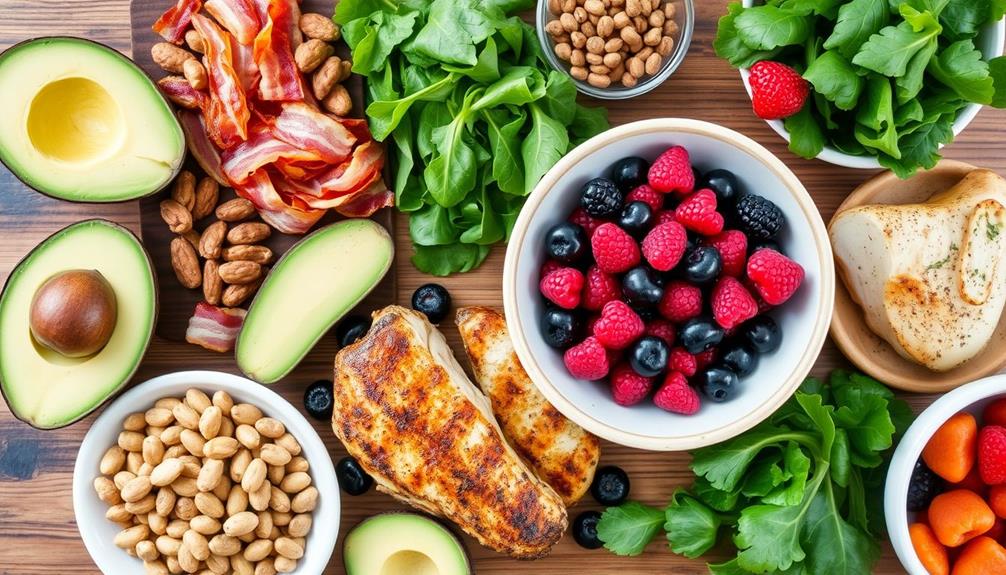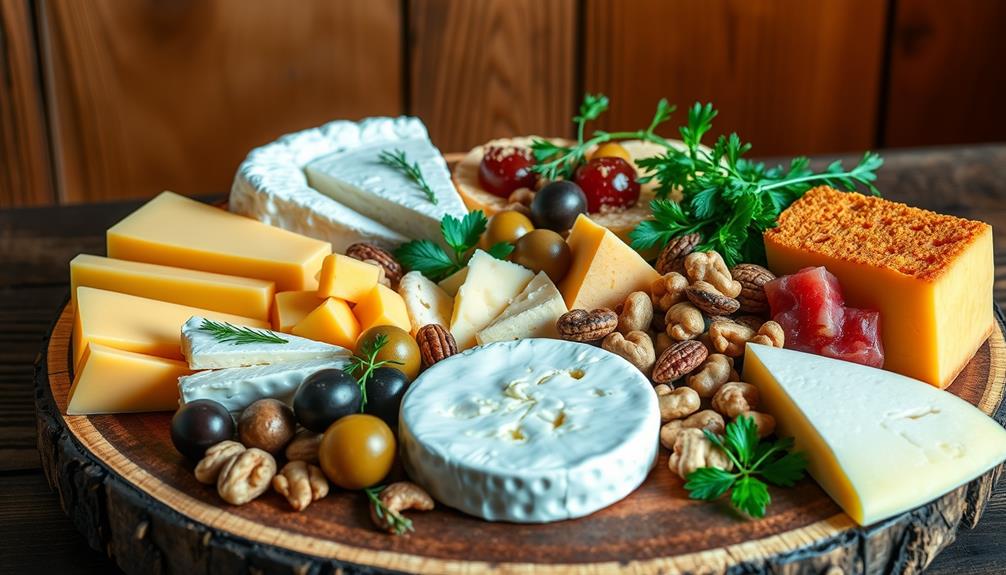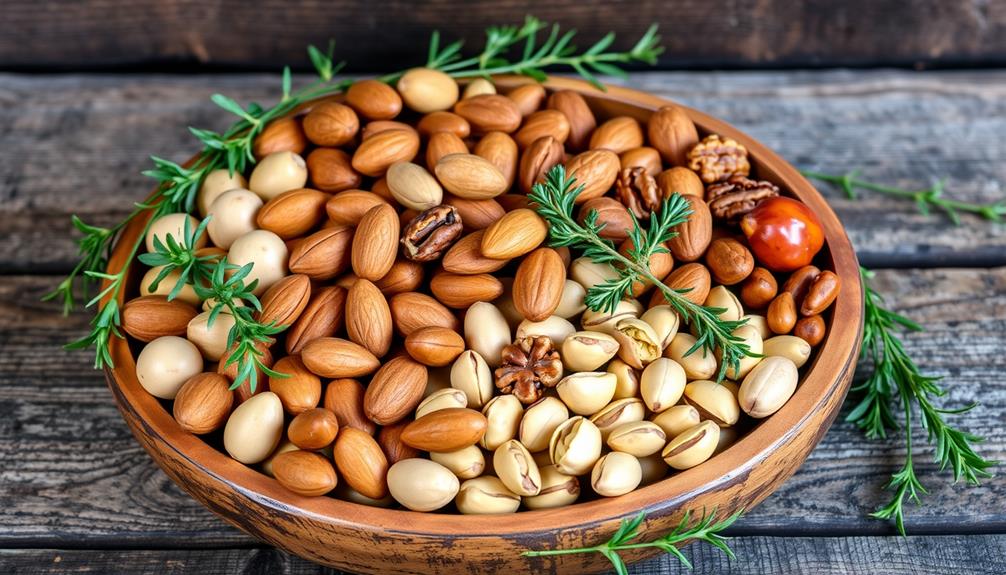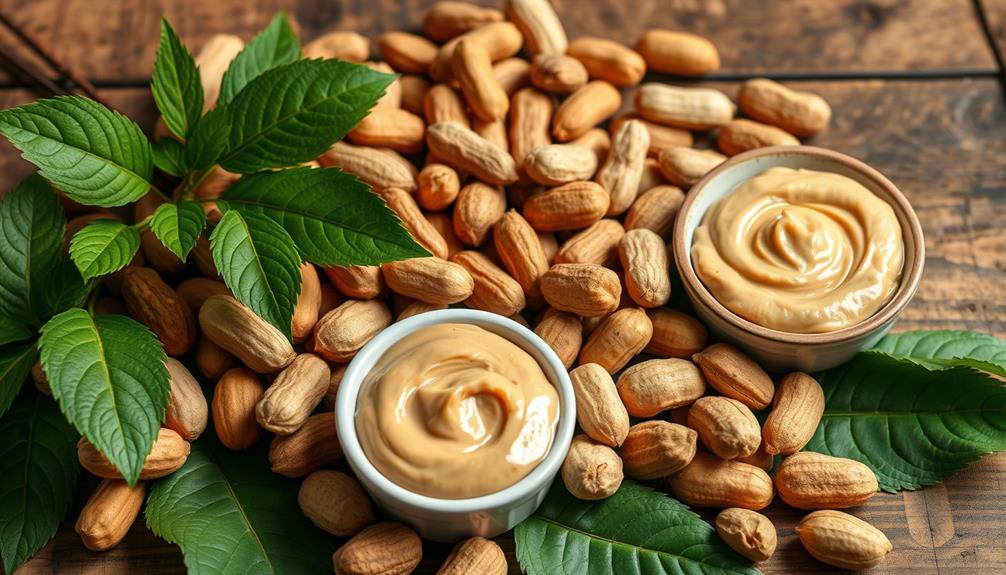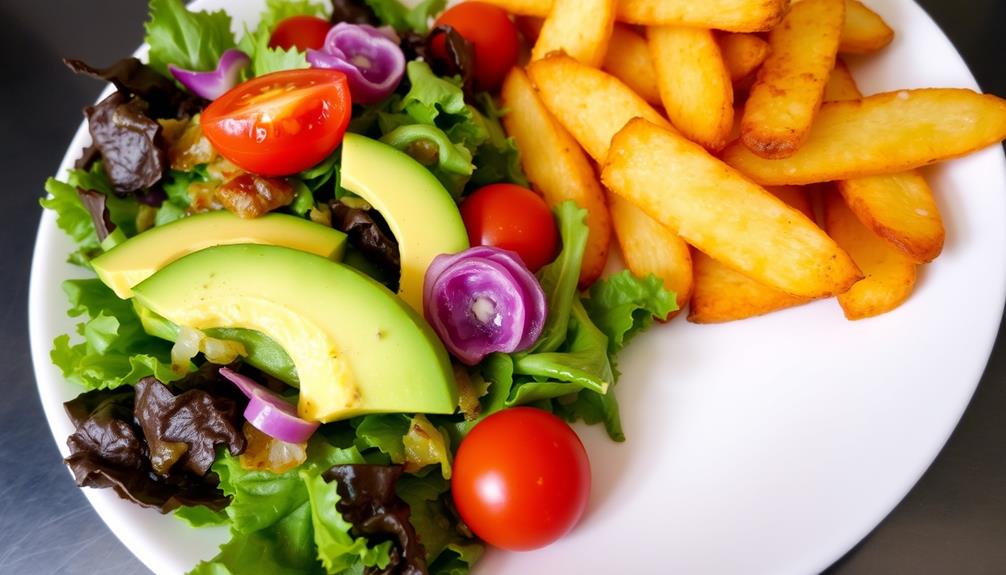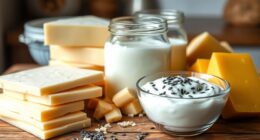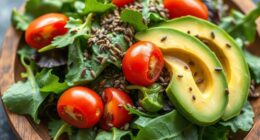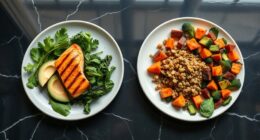On a keto diet, you'll focus on eating low-carb, nutrient-dense foods. Include fresh cuts of beef, chicken, and fatty fish like salmon for high-quality protein and healthy fats. Eggs are great too, as they contain minimal carbs. Don't forget non-starchy vegetables like spinach and broccoli for essential nutrients. Avoid sugary foods, grains, and high-sugar fruits to keep your carb intake low. Plan meals with healthy fats, aiming for 70-80% of your daily calories from fats. Knowing what to eat is vital, and there's so much more to explore to make your keto journey enjoyable and effective. You can also incorporate ketofriendly chicken recipes into your meal planning to keep your diet interesting and satisfying. Experiment with different seasonings and cooking methods to keep things exciting. Don’t be afraid to get creative with your keto-friendly meals and enjoy the delicious variety of foods that align with your nutritional goals.
Key Takeaways
- Focus on high-quality protein sources like fresh beef, chicken, and fatty fish for essential nutrients and minimal carbs.
- Include non-starchy vegetables such as spinach and broccoli to provide vitamins without exceeding carb limits.
- Incorporate healthy fats like olive oil, avocado oil, and butter to meet the diet's high-fat requirements.
- Limit or avoid sugary foods, grains, starchy vegetables, and high-sugar fruits to maintain ketosis.
- Track your daily carb intake, aiming to stay within 20-50 grams of net carbs for optimal weight loss.
Foods to Include
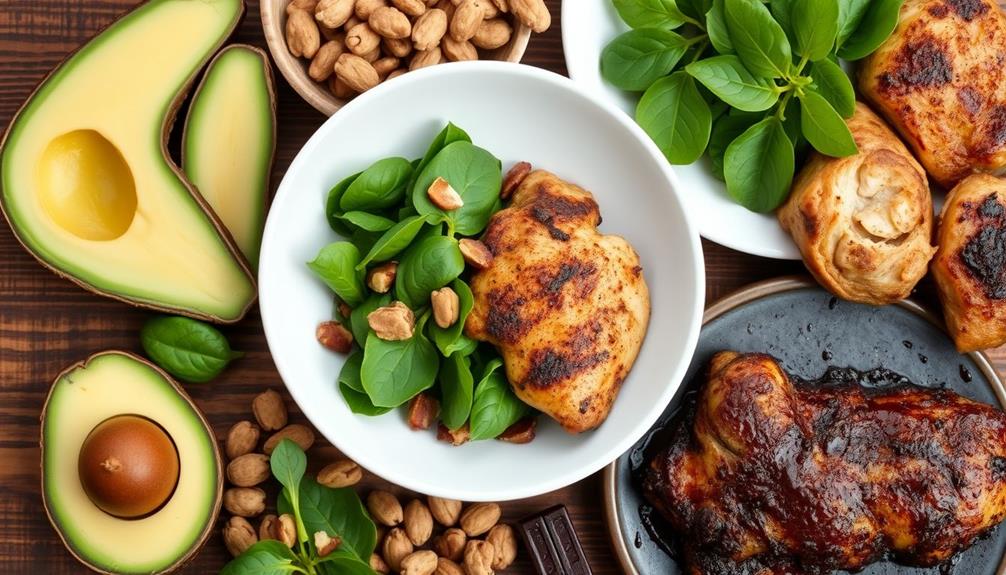
When following a keto diet, it's essential to focus on foods that are low in carbohydrates but high in nutrients. To make your low carb diet successful, prioritize high-quality sources of protein, healthy fats, and non-starchy vegetables.
Including plenty of meat and poultry in your meals guarantees you get essential nutrients, as fresh cuts, like beef and chicken, contain zero carbs and are rich in protein, making them perfect for supporting weight loss. Additionally, fatty fish and seafood, such as salmon and sardines, are also excellent choices. They provide omega-3 fatty acids and are nearly carb-free, allowing you to enjoy their nutritional benefits without exceeding your carb limits. Consuming fish may also offer beneficial health properties that complement your diet.
Don't forget about eggs! They're versatile, with less than 1 gram of carbs per large egg, making them ideal for various meals and snacks. You should also load up on non-starchy vegetables like spinach, broccoli, and zucchini, which are nutrient-dense and low in carbs.
Lastly, incorporate healthy fats into your diet. Avocados and olive oil are great options. A tablespoon of olive oil contains 14 grams of fat with zero carbs, helping you stay satiated while adhering to your keto diet.
Foods to Avoid

To successfully maintain a keto diet, it's crucial to avoid certain foods that can derail your progress. Start by steering clear of sugary foods like candy, soda, and desserts. These items can greatly increase your carb intake and disrupt ketosis, leading to unwanted weight gain.
Additionally, be mindful of the potential side effects and interactions of cold medications if you're ill while trying to stick to your diet.
Next, eliminate grains and pasta from your meals; wheat, rice, oats, and all types of pasta are high in carbohydrates and hinder your keto goals.
Also, be cautious with high-sugar fruits such as bananas, grapes, and mangoes. They've too many carbs to fit into a ketogenic diet.
Likewise, starchy vegetables like potatoes, corn, and sweet potatoes should be avoided, as they can contain over 15 grams of carbs per serving.
Processed foods are another category to limit. Snacks and baked goods like chips, crackers, and even gluten-free products often contain hidden sugars and refined carbs that can sabotage your efforts.
To stay on track, commit to avoiding these foods, and you'll be well on your way to achieving your ketogenic diet goals. Remember, maintaining low carb intake is key!
Meal Planning Tips
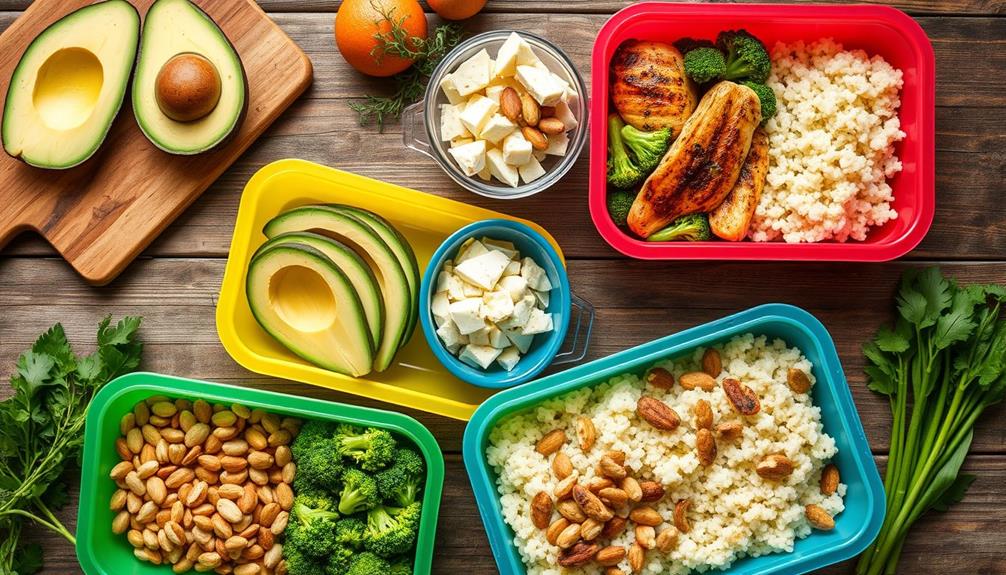
Planning your meals ahead of time can set you up for success on the keto diet. Focus on high-fat, low-carb foods like fatty cuts of meat, full-fat dairy, and non-starchy vegetables to help maintain ketosis and meet your macronutrient targets.
Additionally, understanding common financial terms related to budgeting can help you allocate funds for high-quality ingredients. Incorporate healthy fats such as olive oil, avocado oil, and butter into each meal; they should account for 70-80% of your daily calories.
Utilizing keto-friendly recipes and meal planning tools can simplify this process and keep your diet varied, preventing high-carb temptations. Preparing and packing meals in advance will help you avoid reaching for unhealthy snacks when hunger strikes, ensuring you stick to your keto goals.
Don't forget to track your daily carb intake to stay within the recommended limit of 20-50 grams of net carbs per day. This won't only help maintain ketosis but also optimize your weight loss efforts.
With these meal planning tips, you'll find it easier to navigate the keto diet successfully and enjoy the benefits of a low-carb lifestyle.
Benefits of the Keto Diet

Many people experience remarkable benefits from following the keto diet, making it an appealing choice for those seeking weight loss and improved health. One of the standout advantages is its potential for significant weight loss, with studies showing participants often lose about 2 pounds more than those on traditional low-fat diets. This weight loss stems from the body's shift to burning fat for fuel.
Additionally, the keto diet promotes a balanced diet rich in fruits and healthy fats, which can help enhance overall nutritional intake.
The keto diet also improves insulin sensitivity and helps with blood sugar control, which is particularly beneficial for individuals battling Type 2 diabetes. By reducing sugar intake and promoting healthy fats, you lower your risk of chronic diseases, such as heart disease and certain cancers.
Moreover, the high-fat intake associated with the keto diet may enhance brain health and cognitive function, providing a potential safeguard against conditions like Alzheimer's disease.
Additionally, research indicates that the diet can reduce inflammation in the body, further supporting overall health.
Common Challenges

Adapting to a low-carb lifestyle can be tough, especially in the beginning when you might face symptoms like fatigue and irritability.
These challenges can be compounded by emotional fluctuations, similar to those experienced by individuals with Borderline Personality Disorder (BPD), making it essential to develop effective coping strategies.
You might also struggle with intense food cravings for your favorite high-carb treats, making it hard to stick to your plan.
Understanding these common challenges can help you find strategies to overcome them and stay on track.
Adapting to Low-Carb Lifestyle
Shifting to a low-carb lifestyle often brings a mix of excitement and challenges. As you immerse yourself in keto, you might experience what's known as the "keto flu" during the adaptation phase. This can include fatigue and irritability as your body adjusts to reduced carbohydrate intake.
Understanding the mechanics of your diet, much like the brewing methods in coffee, is fundamental for success. Monitoring your electrolyte levels, especially sodium, potassium, and magnesium, is crucial during this time to prevent headaches and cramps.
Cravings for high-carb foods can also hit hard at first. To combat this, it's important to have keto-friendly snacks on hand, like nuts, cheese, or hard-boiled eggs. These healthy foods can help you stay on track and manage those cravings effectively.
Meal planning plays a key role in your success on a keto diet. Preparing low-carb meals in advance not only prevents impulsive eating but also helps you maintain strict carbohydrate limits.
Additionally, be aware of hidden carbs lurking in many processed items, as these unexpected sugars and starches can derail your progress and hinder your ability to stay in ketosis. By being prepared and informed, you'll adapt more smoothly to your new low-carb lifestyle.
Overcoming Food Cravings
Adjusting to a low-carb diet can bring on intense food cravings, especially during the initial phase when your body is getting used to less sugar and starch.
These cravings can feel overwhelming, but you can manage them with a few strategies. Incorporating practices like yoga for back pain can also help reduce stress and emotional eating triggers.
First, focus on incorporating high-fat snacks into your diet, as they promote satiety and help maintain stable blood sugar levels.
Here are some tips to overcome cravings:
- Stay hydrated: Drink 8-10 cups of water daily to curb hunger cues that dehydration may mimic.
- Plan your meals: Meal planning guarantees you have keto-friendly options ready, minimizing the temptation of high-carb foods.
- Choose high-fat foods: Foods like nuts and cheese can help satisfy your cravings while keeping you in ketosis.
- Practice mindful eating: Savor each bite and identify emotional triggers that lead to cravings.
- Monitor your carbohydrates: Keep track of your carb intake to stay within your limits and avoid triggering cravings.
Nutritional Considerations
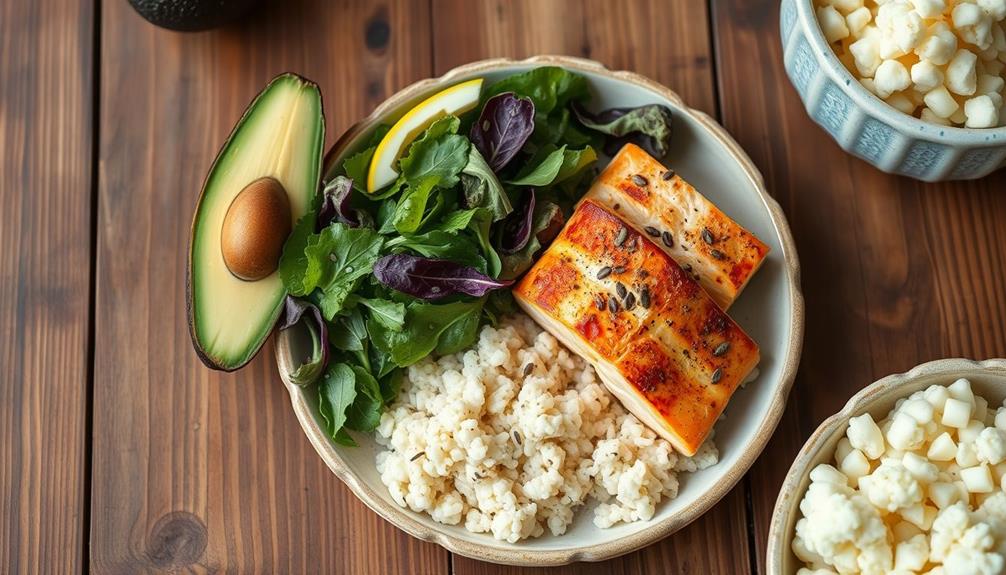
When you're on a keto diet, understanding macronutrient ratios is key to achieving ketosis effectively.
Emphasizing the importance of the power of imagination can help you visualize your health goals and motivate you through challenges.
You'll want to focus on food quality by choosing nutrient-dense options that keep your carb intake in check.
Tracking your carbohydrate consumption closely can help you avoid potential pitfalls and maintain your health as you navigate this lifestyle.
Macronutrient Ratios Explained
Understanding the keto diet's macronutrient ratios is crucial for achieving your health goals. The standard macronutrient distribution for a ketogenic diet typically consists of about 70-80% of total calories from fats, 10-20% from protein, and only 5-10% from carbohydrates.
To reach ketosis, you should aim to consume fewer than 20-50 grams of carbohydrates per day, prompting your body to burn fat for fuel instead of glucose. Incorporating healthy fats can also provide added benefits, such as improved mental clarity and energy levels, similar to the benefits of using essential oils for respiratory health.
Here are some key considerations for your macronutrient ratios:
- Focus on healthy fats like avocados, olive oil, and fatty fish for vital fatty acids.
- Monitor your protein intake, aiming for 1.2 to 2.0 grams per kilogram of body weight.
- Make certain your total calories from fats dominate your diet to maintain ketosis.
- Keep an eye on your nutrient intake to avoid deficiencies in vitamins and minerals.
- Stick to strict macronutrient ratios to optimize your results and support overall health.
Food Quality Matters
While maintaining the right macronutrient ratios is important for the keto diet, the quality of the food you consume plays a significant role in your overall health and wellness. Prioritizing nutrient-dense foods is key. Fatty fish, for instance, provide essential omega-3 fatty acids linked to improved brain health, so aim for at least two 3-ounce servings weekly.
Additionally, it's important to be aware of potential health issues, such as breast cancer symptoms, that can arise with poor dietary choices. Incorporating high-quality animal proteins like grass-fed beef and organic poultry can also enhance your nutrient intake, as they offer more omega-3s and conjugated linoleic acid (CLA), which supports heart health and muscle preservation.
Don't forget to include a variety of low-carb vegetables, especially non-starchy options like spinach, kale, and broccoli. These veggies are packed with vitamins and antioxidants while keeping your carb intake low.
Additionally, choose full-fat dairy products such as cheese and Greek yogurt, which are rich in calcium and protein, contributing to satiety and overall health.
Tracking Carb Intake
Tracking your carb intake is vital for successfully following a keto diet. To achieve and maintain ketosis, you need to limit your daily carb intake to under 20-50 grams. This means focusing on net carbs—total carbohydrates minus fiber and sugar alcohols—since fiber doesn't impact blood sugar and aids digestion.
Here are some tips to help you stay on track:
- Use food tracking apps to monitor your daily carb intake.
- Pay attention to nutrition labels, especially for processed foods that may have hidden sugars.
- Incorporate low-carb vegetables, like leafy greens, which typically have less than 8 grams of net carbs per cup.
- Keep an eye on your fiber intake, as it plays a significant role in digestion without affecting your carb limits.
- Regularly review your dietary goals to guarantee you're aligned with your keto objectives.
Frequently Asked Questions
What Is a List of Foods You Can Eat on the Keto Diet?
You can enjoy fatty fish like salmon, fresh meats, eggs, full-fat cheeses, and non-starchy veggies. These foods provide essential nutrients while keeping your carb intake low, making them perfect for your keto lifestyle.
What Foods Are Not Allowed on Keto?
On a keto diet, you can't eat high-carb foods like grains, starchy vegetables, sugary treats, and most fruits. Processed items, even gluten-free ones, are off-limits too. Focus on low-carb alternatives instead.
What Are the Basic Rules for Keto?
To thrive on keto, you'll embrace high-fat delights while shunning sugary temptations. Keep your carbs low, monitor your intake, and prioritize whole foods, ensuring your body enters that coveted state of ketosis for ideal health.
Can You Eat Bananas on Keto?
You can't eat bananas on keto. Their high carb content exceeds your daily limit, potentially disrupting ketosis. Instead, focus on lower-carb fruits like berries to satisfy cravings while keeping your carbohydrate intake in check.
Conclusion
In summary, a keto diet can transform your eating habits and support your health goals. By focusing on high-fat, low-carb foods, you'll not only lose weight but also enjoy more energy. For example, Sarah, who struggled with cravings, found that incorporating avocados and nuts helped her feel satisfied and curb her appetite. With the right planning and mindset, you can conquer the challenges and embrace a healthier lifestyle through keto. Start experimenting with delicious recipes today!
